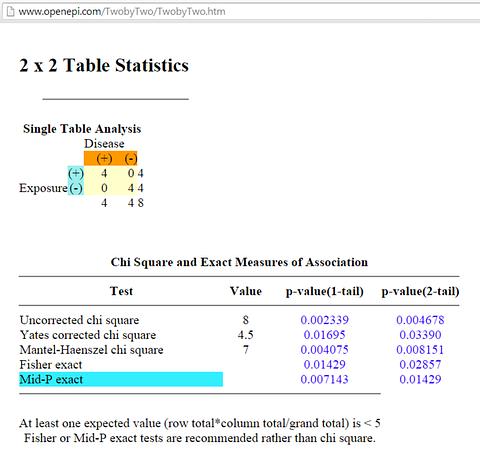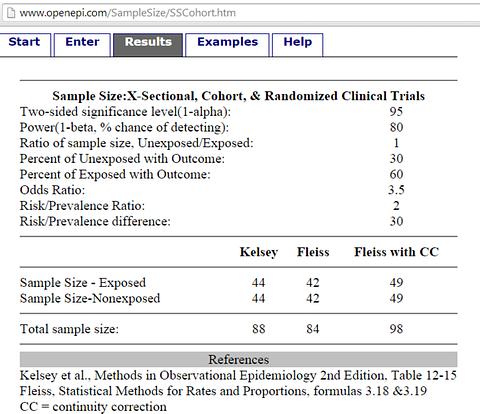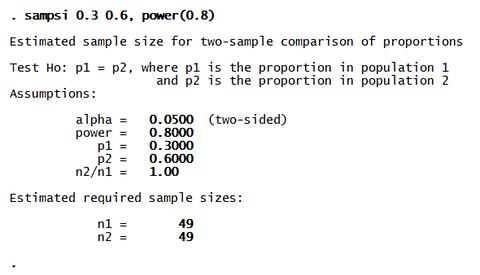Effect Size
Effect Size (size of effect)
ถ้า Effect Size มีค่ามากๆ เช่น ต่างกันถึง 1000 : 1
Sample Size จำนวนน้อย เช่น n1=4, n2=4 ก็เพียงพอสำหรับ
การทดสอบทางสถิติ var1 และ var2 มี Association
p-value (2-sided) = 0.029
Significant ที่ alpha = 0.05 power= 0.80
Exposed with Outcome / Unexposed with Outcome = 1000 / 1
กรณีของ
1) Correlation, Regression Coefficient ระหว่างตัวแปรต้นกับตัวแปรตาม
2) ความต่างกันของค่าเฉลี่ย (Means different)
3) ความต่างกันของ Outcome ของกลุ่ม Exposed และ Unexposed,
Association, Risk ratio, Odds Ratio
Link to Website
Effect Size
กรณีตัวแปรที่ได้จากการนับ คือ Association, Risk Ratio, Odds Ratio
Effect Size คือ Ratio ของ proportion หรือ odds
ของ (Exposed with Outcome) และ (Unexposed with Outcome)
(Exposed with Outcome) คือตัวแปรตามที่มีตัวแปรต้นหรือได้รับตัวแปรต้น
(Unxposed with Outcome) คือตัวแปรตามที่ไม่มีตัวแปรต้นหรือไม่ได้รับตัวแปรต้น
ถ้า Effect Size มีค่ามาก ไม่ว่าทิศทางบวกหรือลบ
จะทำให้ Sample Size น้อยลง
ถ้ากำหนดให้ Outcome ต่างกันมาก ๆ โดยที่ alpha 5%, Power 80% (Power = 1-beta)
Effect Size 99.9 % และ 0.1 % เพื่อให้ ค่าต่างกัน 1000 เท่า
ไม่สูบบุหรี่และป่วย (Unexposed with Outcome) = 0.1%
สูบบุหรี่และป่วย (Exposed with Outcome) = 99.9%
Sample size by OpenEpi, n1 = 4, n2 = 4
Sample size by STATA, n1 = 4, n2 = 4

ทดลองคำนวณค่า p-value
Exposed with Outcome = 4, Unexposed with Outcome = 4
2x2 table
1) a=4, b=0, c=0, d=4 p-value (2-tail) = 0.028
2) a=3, b=1, c=1, d=3 p-value (2-tail) = 0.485
3) a =2, b=2, c=2, d=2 p-value (2-tail) = 1
4) a =3, b=3, c=1, d=1 p-value (2-tail) = 1
...,
เนื่องจาก Effect Size มีค่ามาก
Exposed with Outcome / Unexposed with Outcome = 1000 / 1
ที่เป็นไปได้ง่าย คือ 1) เป็นไปได้ยาก ที่จะเป็น ข้อ 2), 3), ...
ทดลองคำนวณค่า p-value จาก 1) a=4, b=0, c=0, d=4
OpenEpi คำนวณค่า Fisher's exact p-value (2-tail) = 0.028
STATA คำนวณค่า Fisher's exact p-value (2-tail) = 0.029
Cross-sectional Study, Cohort, Randomize Control Trial
ถ้า Exposed with Outcome / Unexposed with Outcome = 2 / 1
คาดว่า Exposed มี Effect คือเพิ่ม Outcome จากเดิมเป็น 2 เท่า
ไม่สูบบุหรี่ป่วย = 30%
สูบบุหรี่ป่วย = 60%
(กำหนด alpha 5%, Power 80%)
Sample size by OpenEpi, n1 = 49, n2 = 49
Sample size by STATA, n1 = 49, n2 = 49
"In statistics, an effect size is a quantitative measure of the strength of a phenomenon.
Examples of effect sizes are
- the correlation between two variables, the regression coefficient,
- the mean difference, or even
- the risk with which something happens,
such as how many people survive after a heart attack
for every one person that does not survive.
For each type of effect-size,
a larger absolute value always indicates a stronger effect."
"Effect sizes complement statistical hypothesis testing,
and play an important role in statistical power analyses,
sample size planning, and in meta-analyses."
source:
http://en.wikipedia.org/wiki/Effect_size
Always present effect sizes for primary outcomes...
If the units of measurement are meaningful on a practical level
(e.g., number of cigarettes smoked per day), then
we usually prefer an unstandardized measure
(regression coefficient or mean difference) to a standardized measure (r or d).
source: L. Wilkinson and APA Task Force on Statistical Inference (1999, p. 599)
Link to Website at DropBox
[ Effect Size ]
ความเห็น (0)
ไม่มีความเห็น






